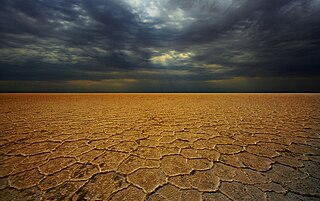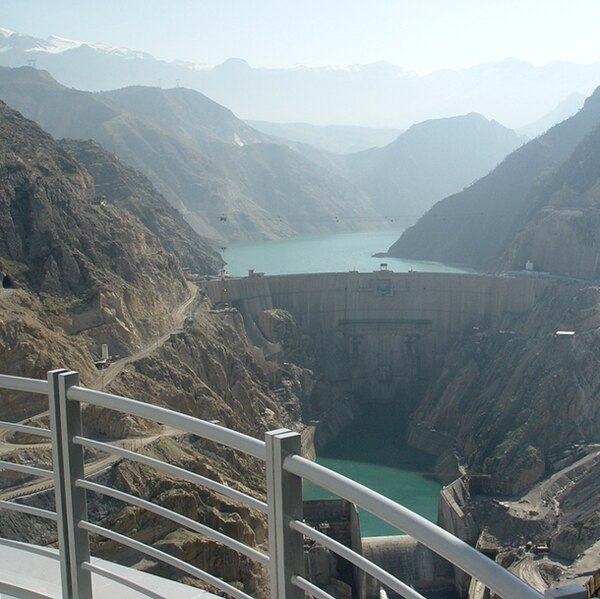David Michel
 Iran faces growing environmental challenges that are now more perilous to the country’s long-term stability than either foreign adversaries or domestic political struggles. More than two-thirds of the country’s land—up to 118 million hectares—is rapidly turning into desert, Iran’s Forest, Range and Watershed Management Organization reported in mid-2013. “The main problem that threatens us [and is] more dangerous than Israel, America or political fighting… is that the Iranian plateau is becoming uninhabitable,” presidential adviser Issa Kalantari warned in the newspaper Ghanoon. “If this situation is not reformed, in 30 years Iran will be a ghost town.” He described an alarming future of desiccated lakes and depleted groundwater, potentially driving millions of Iranians from their homes.
Iran faces growing environmental challenges that are now more perilous to the country’s long-term stability than either foreign adversaries or domestic political struggles. More than two-thirds of the country’s land—up to 118 million hectares—is rapidly turning into desert, Iran’s Forest, Range and Watershed Management Organization reported in mid-2013. “The main problem that threatens us [and is] more dangerous than Israel, America or political fighting… is that the Iranian plateau is becoming uninhabitable,” presidential adviser Issa Kalantari warned in the newspaper Ghanoon. “If this situation is not reformed, in 30 years Iran will be a ghost town.” He described an alarming future of desiccated lakes and depleted groundwater, potentially driving millions of Iranians from their homes. Iran now ranks 114 of 132 countries evaluated on 22 environmental indicators, including water resources, air pollution, biodiversity and climate change, according to the 2012 Environmental Performance Index compiled by Yale and Columbia Universities.
Water
Iran’s fresh water supplies are now under unsustainable strains. Ninety percent of the country—which is slightly smaller than Alaska—is arid or semi-arid, and an estimated two-thirds of its rainfall evaporates before it can replenish rivers. As a result, Iran provides more than half of its water needs by drawing from underground aquifers, but public usage is rapidly draining the subterranean reservoirs. At current rates of overuse, twelve of Iran’s thirty-one provinces will exhaust their groundwater reserves within the next 50 years.
Iran’s economic policies have exacerbated the problem. Groundwater is free to well owners and, due to government subsidies, users pay a fraction of the actual energy costs for pumping water to the surface. Iran annually pumps 4 billion cubic meters of groundwater that nature does not replenish.
 Iran’s surface waters face similar pressures. Most of Iran’s rivers are hydrologically closed or nearly so, meaning their renewable water supply is already committed. So they have little spare capacity for regularly recurring dry years – when precipitation falls below the average – much less to meet the demands of a growing population. Water use upstream also increasingly impinges on water needs downstream. In the northwest, Iran’s dams (such as the Karun-3, left), irrigation systems, and drought have so diminished the 13 rivers feeding into Lake Urmia that the Middle East’s largest lake has shrunk more than 60 percent since 1995. In the southwest, Lake Bakhtegan, once Iran’s second largest lake, has dried up completely under the combined impacts of prolonged drought and damming on the Kor River.
Iran’s surface waters face similar pressures. Most of Iran’s rivers are hydrologically closed or nearly so, meaning their renewable water supply is already committed. So they have little spare capacity for regularly recurring dry years – when precipitation falls below the average – much less to meet the demands of a growing population. Water use upstream also increasingly impinges on water needs downstream. In the northwest, Iran’s dams (such as the Karun-3, left), irrigation systems, and drought have so diminished the 13 rivers feeding into Lake Urmia that the Middle East’s largest lake has shrunk more than 60 percent since 1995. In the southwest, Lake Bakhtegan, once Iran’s second largest lake, has dried up completely under the combined impacts of prolonged drought and damming on the Kor River.Agriculture Imperiled
Iran’s water problems now risk undermining the national economy. The agricultural sector produces 10 percent of Iran’s GDP and employs a quarter of the labor force. It also supports national food security, a top priority since the 1979 revolution was carried out in the name of “the oppressed.” Indeed, Tehran subsidizes producers and consumers alike in a dual strategy to promote self-sufficiency in staple crops by bolstering both supply and demand.
 Yet Iran’s food security is now imperiled because agriculture accounts for more than 92 percent of the country’s water use but only produces about 66 percent of the food supplies for 79 million people. Tehran has to import the rest. And the intensifying “water stress” threatens to further sap agricultural output, increase import bills and aggravate fiscal burdens. Agricultural demands are even subverting food security. Some areas, such as the central Kashan plain, have been rendered unfit for farming because of soil salinity, as groundwater overdrafts sink water tables.
Yet Iran’s food security is now imperiled because agriculture accounts for more than 92 percent of the country’s water use but only produces about 66 percent of the food supplies for 79 million people. Tehran has to import the rest. And the intensifying “water stress” threatens to further sap agricultural output, increase import bills and aggravate fiscal burdens. Agricultural demands are even subverting food security. Some areas, such as the central Kashan plain, have been rendered unfit for farming because of soil salinity, as groundwater overdrafts sink water tables.Tough Choices
Competition over scarce water has already fueled conflict both within Iran and with its neighbors. In early 2013, farmers outside Isfahan destroyed a pump that diverted water from a local river to the city of Yazd some 185 miles away. Outraged at the loss of water, protestors refused to allow authorities to repair the pump, sparking week-long demonstrations, armed clashes with police, and water shortages and rationing in Yazd. In 2011, Iranian border guards exchanged fire with Afghan forces after crossing into Afghanistan to release water from an 18-mile irrigation canal from the Helmand River. And in the 1980s, the longest modern Middle East war was ignited by rival claims of control over the strategic Shatt-al Arab waterway between Iran and Iraq.
The escalating pressures on Iran’s water resources raise difficult choices for competing consumers. In the Karkheh Basin, water managers have to decide what to do about lower river flows—whether to retain water in the Karkheh Dam to build reserves for hydropower or whether to release water downstream for irrigation to a region considered to be Iran’s food basket.
Pollution
Iran faces other serious environmental risks. According to the World Health Organization, Iran has three of the world’s five most polluted cities—Ahwaz, Kermanshah, and Sanandaj—that are choked by annual levels of air pollution that are ten to eighteen times higher than WHO’s maximum guidelines. Because of its poor air quality nationwide, Iran ranked 86 out of 91 countries surveyed. In Tehran (see below) alone, contaminants in air pollution cause more than 5,500 deaths each year from cardiovascular and respiratory diseases.
 Global climate change is also expected to worsen Iran’s environmental woes. Changes in temperature and precipitation will lessen access to clean water, especially in rural areas, in turn generating more water-borne diseases, according to Iran’s Department of Environment. Higher temperatures and lower rainfall could cut cereal yields up to 30 percent by 2050. Climate change could reduce Iran’s total renewable water resources 15 percent to 19 percent by 2040-2050, according to a Dutch analysis. Iran’s annual water demand would then exceed its renewable supplies by more than 40 percent.
Global climate change is also expected to worsen Iran’s environmental woes. Changes in temperature and precipitation will lessen access to clean water, especially in rural areas, in turn generating more water-borne diseases, according to Iran’s Department of Environment. Higher temperatures and lower rainfall could cut cereal yields up to 30 percent by 2050. Climate change could reduce Iran’s total renewable water resources 15 percent to 19 percent by 2040-2050, according to a Dutch analysis. Iran’s annual water demand would then exceed its renewable supplies by more than 40 percent.The Toll
The damage – from water stress, desertification and pollution--could impose debilitating burdens long-term. The annual cost of Iran’s environmental degradation already amounts to a whopping 5 percent to 10 percent of GDP, according to the World Bank. In contrast, tough U.S. and international sanctions shrunk Iran’s GDP by some 1.4 percent in 2012, according to the U.S. Government Accountability Office. Over time, valuable resources will be further depleted, productivity diminished, and public health damaged.
Mismanagement has contributed to Iran’s environmental problems. Its cities lose one-third of their water supplies in leaky pipes. Irrigation is also highly inefficient; more than half of Iran’s renewable water used in agriculture is lost. Surmounting Iran’s environmental challenges will require serious reorientation of policies and resources. The cost of new technologies, conservation practices and other measures to meet projected water needs in 2050 could top $3 billion a year, experts say.
Iran has recently taken important steps in the right direction. Subsidy reforms initiated in 2010 will gradually require consumers to absorb the actual costs of water supplies, enhancing the incentives to be efficient. Revenues saved from cutting back energy subsidies are intended to support initiatives to reduce greenhouse gas emissions and air pollution. But the subsidy reforms stalled after phase one. They were also not designed or intended to deal with environmental challenges. Iran’s looming environmental crisis will require a comprehensive green revolution in national policy-making.
David Michel is director of the Environmental Security Program at the Stimson Center, a non-partisan think tank in Washington D.C.
Online news media are welcome to republish original blog postings from this website in full, with a citation and link back to The Iran Primer website (www.iranprimer.com) as the original source. Any edits must be authorized by the author. Permission to reprint excerpts from The Iran Primer book should be directed to permissions@usip.org
Photo credits:
Maranjab desert in Iran by by Siamaksabet (Own work) [CC-BY-SA-3.0 (http://creativecommons.org/licenses/by-sa/3.0)], via Wikimedia Commons
Karun-3 dam by Zereshk via [CC-BY-SA-3.0 (http://creativecommons.org/licenses/by-sa/3.0)], via Wikimedia Commons
Fieds in Eghlid county by Alireza Javaheri (Iran - Fars - Eghlid - Timargun (Namdan)) [CC-BY-3.0 (http://creativecommons.org/licenses/by/3.0)], via Wikimedia Commons
Tehran Pollution by Matthias Blume [CC-BY-SA-2.0 (http://creativecommons.org/licenses/by-sa/2.0)], via Wikimedia Commons
